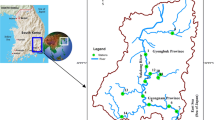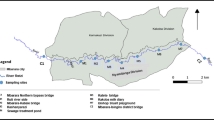Abstract
The purpose of this paper are to determine the concentration of heavy metals namely cadmium (Cd), copper (Cu) and lead (Pb) in water and sediment; and to investigate the effect of sediment pH and sediment organic matter on concentration of cadmium, copper and lead in sediment at oxidation fraction. For this purpose the concentration of heavy metals were measured in water and sediments at 15 sites from Tasik Chini, Peninsular Malaysia. The sequential extraction procedure used in this study was based on defined fractions: exchangeable, acid reduction, oxidation, and residual. The concentration of heavy metals in residual fraction was higher than the other fractions. Among the non-residual fractions, the concentration of heavy metals in organic matter fraction was much higher than other fractions collected from all sampling sites. The pH of the sediment in all sites was acidic. The mean pH ranges from 4.8 to 5.5 with the higher value observed at site 15. Results of organic matter analysis showed that the percentage of organic matter present in sediment samples varies throughout the lake and all sites of sediments were relatively rich in organic matter ranging from 13.0% to 34.2%. The highest mean percentage of organic matter was measured at sampling site 15, with value of 31.78%.
Similar content being viewed by others
References
Andrews, S., & Sutherland, R. A. (2004). Cu, Pb and Zn contamination in Nuuanu watershed, Oahu, Hawaii. Science of the Total Environment, 324, 173–182.
Avila-Pèrez, P., Balcazar, M., Zarazua-Ortega, G., Barcelo-Quintal, I., & Díaz-Delgado, C. (1999). Heavy metal concentrations in water and bottom sediments of a Mexican reservoir. Science of the Total Environment, 234, 185–196.
Badri, M. A., & Aston, S. R. (1983). Observation on heavy metal geochemical association in polluted and non-polluted estuarine sediments. Environmental Pollution, Series B, 6, 181–183.
Baldantoni, D., Alfani, A., & Tommasi, P. D. (2004). Assessment of macro and microelement accumulation capability of two aquatic plants. Environmental Pollution, 130, 149–156.
Byrd, J. E, & Perona, M. J. (1980). The temporal variations of the lead concentration in a freshwater lake. Water, Air, and Soil Pollution, 13, 207–220.
Camusso, M., Vigano, L., & Baitstrini, R. (1995). Bioaccumulation of trace metals in rainbow trout. Ecotoxicology and Environmental Safety, 31, 133–141.
Clements, W., & Newman, M. (2002). Community ecotoxicology. New York: Wiley.
Dean, J. R. (2002). Methods for environmental trace analysis. New York: Wiley.
Eimers, M. C., Evans, R. D., & Welbourn, P. M. (2001). Cadmium accumulation in the freshwater isopod Asellus racovitzai: The relative importance of solute and particulate sources at trace concentrations. Environmental Pollution, 111, 247–253.
Elith, M., & Garwood, S. (2001). Investigation into the levels of heavy metals within Manly Dam Catchment. In: Freshwater ecology report 2001. Sydney: Department of Environmental Sciences, University of Technology.
Fernandes, H. M. (1997). Heavy metal distribution in sediments and ecological risk assessment: The role of diagenetic processes in reducing metal toxicity in bottom sediments. Environmental Pollution, 97, 317–325.
Forstner, U. (1985). Chemical forms and reactivities of metals in sediment. In R. Leschber, R. D. Davids, Ľ. Hermite (Eds), Chemical methods for assessing bio-available metals in sludges and soils (pp. 1–30). London: Elsevier.
Gangaiya, P., Tabudravu, J., South, R., & Sotheeswaran, S. (2001). Heavy metal contaminationof the Lami coastal environment, Fiji. South Pacific Journal of Natural Science, 19, 24–29
Guevara-Riba, A., Sahuquillo, A., Rubio,R., & Rauret, G. (2004). Assessment of metal mobility in dredged harbour sediments from Barcelona, Spain. Science of the Total Environment, 321, 241–255.
Ho, S. T., Tsai L. J., & Yu, K. C. (2003). Correlations among aqua- regia extractable heavy metals in vertical river sediments. Diffuse Pollution Conference, Dublin, 1, 12–18.
Ikem, A. Egiebor, O. N. & Nyavor, K. (2003). Trace elements in water, fish and sediment from Tuskegee Lake, southern USA. Water, Air, and Soil Pollution, 149, 51–75
Islam, S. M., Barazani, M. G., & Rahim, S. A. (2005). Chini Lake integrated lake management. Paper presented at the Proceeding of the Second Regional Symposium on Environment and Natural Resources, Kuala Lumpur, March.
Kabala, C., & Singh, B. (2001). Fractionation and mobility of copper, lead, and zinc in soil profiles in the vicinity of a copper smelter. Journal of Environmental Quality, 30, 485–492.
Kabata-Pendias, A., & Pendias, H. (2001). Trace elements in soils and plants (3rd ed.). Boca Raton, FL: CRC Press.
Kong, I. H., & Liu, S. H. (1995). Determination of heavy metals distribution in the anoxic sediment slurries by chemical sequential fraction. Ecotoxicology and Environmental Safety, 32, 34–38.
Ma, L. Q., & Rao, G. N. (1997). Chemical fractionation of cadmium, copper, nickel, and zinc in contaminated soils. Journal of Environmental Quality, 26, 259–264.
Madejon, P., Murillo, J. M., Maranon, T., Cabrera, T. F., & Lopez, F. (2002). Bioaccumulation of As, Cd, Cu, Fe and Pb in wild grasses affected by the Aznalcollar mine spill (SW Spain). Science of the Total Environment, 290, 105–120.
Manta, D. S., Angelone, M., Bellanca, A., Neri, R., & Sprovieri, M. (2002). Heavy metals in urban soils: A case study from the city of Palermo (Sicily), Italy. Science of the Total Environment, 300, 229–243.
Namminga, H. N., & Wilhm, J. (1976). Effects of high discharge and an oil refinery cleanup operation bon heavy metals in water and sediments in Skeleton Creek. Proceedings of the Oklahoma Academy of Science, 56, 133–138.
Otero, X. L., Huerta-Diaz, M. A., & Macias, F. (2000). Heavy metal geochemistry of saltmarsh soils from the RIA a of Ortigueira (mafic and ultramafic areas, NW Iberian Peninsula). Environmental Pollution, 110, 285–296.
Pagnanelli, F., Moscardin, E., Giuliano, V., & Toro, L. (2004). Sequential extraction of heavy metals in river sediments of an abandoned pyrite mining area: Pollution detection and affinity series. Environmental Pollution, 132, 189–201.
Preda, M., & Cox, M. E. (2002). Trace metal occurrence and distribution in sediments and mangroves, Pumicestone region, southeast Queensland, Australia. Environment International, 28, 433–449.
Samecka-Cymerman, A., & Kempers, A. J. (2001). Concentrations of heavy metals and plant nutrients in water, sediments and aquatic macrophytes of anthropogenic lakes former open cut brown coal/mines differing in stage of acidification. Science of the Total Environment, 281, 87–98.
Storelli, M. M., Storelli, A., D’ddabbo, R., Marano, C., Bruno, R., & Marcotrigiano, G. O. (2005). Trace elements in loggerhead turtles (Caretta caretta) from the eastern Mediterranean Sea: Overview and evaluation. Environmental Pollution, 135, 163–170.
Tokalioglu, Ş., Karta, Ş., & Elçi, L. (2000). Speciation and determination of the heavy metals in lake waters by atomic absorption spectrometry after sorption on Amberlite XAD-16 Resin. Analytical Sciences, 16, 1169–1174.
Vogel-Mikus, K., Drobne, D., & Regvar, M. (2005). Zn, Cd and Pb accumulation and arbuscular mycorrhizal colonisation of pennycress Thlaspi praecox Wulf. (Brassicaceae) from the vicinity of a lead mine and smelter in Slovenia. Environmental Pollution, 133, 233–242.
Wang, H., Wang, C. X., Wang, Z. I., & Cao, Z. H. (2004). Fractionation of heavy metals in surface sediments of Taihu Lake, East China. Environmental Geochemistry and Health, 26, 303–309.
Xiangdong, L., Zhenguo, S., Onyx, W. H. W., & Yok-sheung L. (2000). Chemical partitioning of heavy metal contaminants in sediments of the Pearl River Estuary. Chemical Speciation and Bioavailability, 12, 17–25.
Author information
Authors and Affiliations
Corresponding author
Rights and permissions
About this article
Cite this article
Ebrahimpour, M., Mushrifah, I. Heavy metal concentrations in water and sediments in Tasik Chini, a freshwater lake, Malaysia. Environ Monit Assess 141, 297–307 (2008). https://doi.org/10.1007/s10661-007-9896-7
Received:
Accepted:
Published:
Issue Date:
DOI: https://doi.org/10.1007/s10661-007-9896-7




